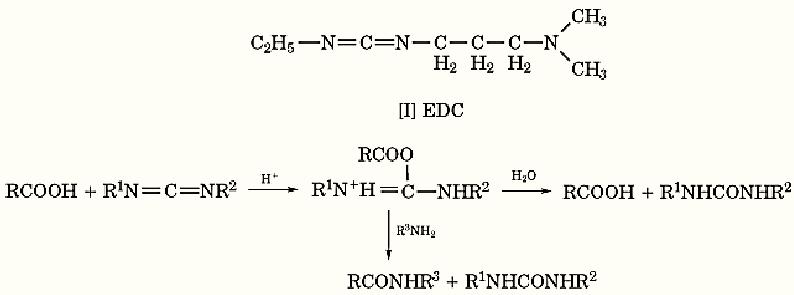


 النبات
النبات
 الحيوان
الحيوان
 الأحياء المجهرية
الأحياء المجهرية
 علم الأمراض
علم الأمراض
 التقانة الإحيائية
التقانة الإحيائية
 التقنية الحيوية المكروبية
التقنية الحيوية المكروبية
 التقنية الحياتية النانوية
التقنية الحياتية النانوية
 علم الأجنة
علم الأجنة
 الأحياء الجزيئي
الأحياء الجزيئي
 علم وظائف الأعضاء
علم وظائف الأعضاء
 الغدد
الغدد
 المضادات الحيوية
المضادات الحيوية|
Read More
Date: 24-5-2021
Date: 22-12-2015
Date: 4-6-2021
|
Carboxyl Groups

A carboxyl group has the formula COOH. Among compounds that have a carboxyl group are carboxylic acids. A carboxyl group shows relatively weak acidity. Many carboxylic acids are found in nature as free acids or in the form of esters, amides, or salts. Biologically important acids are those found in the metabolic pathways of glycolysis, fatty acids, amino acids, and so on. A carboxylic acid reacts with a base to form a salt and can be reduced to an aldehyde and an alcohol. A carboxylic acid forms an ester with an alcohol, an amide with an amine, and an acid anhydride with an carboxylic acid. Carboxyl groups are not very reactive, and some catalyst or activation processes are required for their reactions.
There are three kinds of carboxyl groups in proteins, the C-terminal a-carboxyl, the b-carboxyl of aspartic acid, and the g-carboxyl of glutamic acid. They have intrinsic pKa values of 3.8, 4.0, and 4.4, respectively. Carboxyl groups are often employed as catalytic groups in enzymes, and they often play critical roles in ligand binding. Thus, carboxyl groups are important in protein chemistry.
1. Chemical Modification of Carboxyl Groups in Proteins
Esterification and amidation are the usual chemical modifications of carboxyl groups (1). Carboxyl groups in proteins are esterified by treating the dry protein with methanol-HCl. However, this method is drastic and not suitable for selective modification of carboxyl groups. Trialkyloxonium salts, such as triethyloxonium tetrafluoroborate, are commonly used for mild esterification of carboxyl groups in proteins (2). Diazoacetyl compounds, such as diazoacetamide, methyl diazoacetate, and N-diazoacetylglycinamide, react with carboxyl groups at acidic pH to form esters. Other reagents, such as acid halogen compounds and ethyleneimine have also been used to esterify the carboxyl groups in proteins.
Carboxyl groups are amidated with simple amines after activating the carboxyl groups with water soluble carbodiimides, such as 1-ethyl-3-(3-dimethylaminopropyl) carbodiimide (EDC) [I]. At pH 4.75 to 5, the reaction proceeds as in Scheme 1. Exhaustive amidation is achieved by using high concentrations of both amine (1 M) and EDC (0.1 M) at pH 4.75 under denaturing conditions (3). Limited amidation is possible using low concentrations of amine (0.1 M) and EDC (2.6 mM) under mild conditions at pH 5.0 (4). Isoxazolium salts, including Woodward's Reagent K (2-ethyl-5-phenylisoxazolium 3′-sulfonate), can be used in the place of EDC at pH 3 to 5. Amidation is also achieved by ammonolysis of the esters in liquid ammonia at –55°C. In this case, selective amidation is possible starting with a selectively esterified protein (5).
References
1. T. Imoto and H. Yamada (1989) In Protein Structure: A Practical Approach (T. E. Creighton, ed.), IRL Press, Oxford, U.K., pp. 247–277.
2. S. M. Parsons et al. (1969) Biochemistry 8, 700–712.
3. T.-Y. Lin and D.E. Koshland Jr. (1969) J. Biol. Chem. 244, 505–508.
4. H. Yamada et al. (1981) Biochemistry 20, 4836–4842.
5. R. Kuroki et al. (1986) J. Biol. Chem. 261, 13571–13574.



|
|
|
|
5 علامات تحذيرية قد تدل على "مشكل خطير" في الكبد
|
|
|
|
|
|
|
تستخدم لأول مرة... مستشفى الإمام زين العابدين (ع) التابع للعتبة الحسينية يعتمد تقنيات حديثة في تثبيت الكسور المعقدة
|
|
|